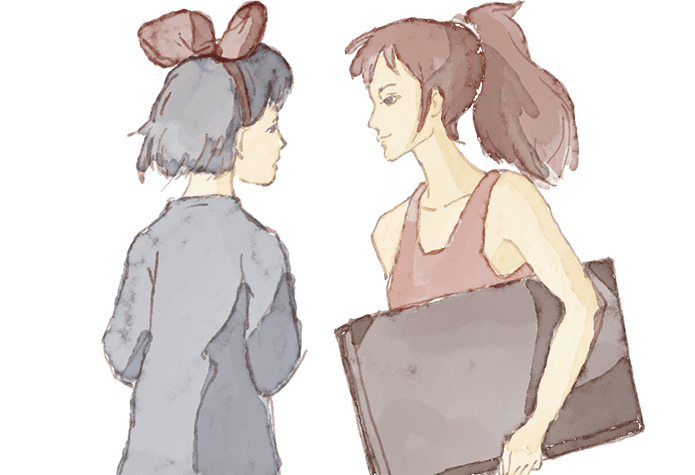Finding myself in a nostalgic mood one recent Sunday afternoon, I decided to revisit Kiki’s Delivery Service. Despite the film being a childhood favourite of mine, I hadn’t seen it for years. The plastic video jacket had faded, and the old VHS player required a few decent thumps until it jolted, reluctantly, into action. However, as soon as the charming piano tune began to play and the screen was filled with those familiar pastel colours, I was six years old again, sprawled upon the carpet with my eyes glued to the TV. Watching Kiki’s Delivery Service this time, though, I found magic not so much in its depiction of witches, talking cats and flying broomsticks, but in its deep thematic complexities.
Directed by Hayao Miyazaki and released by Studio Ghibli in 1989, Kiki’s Delivery Service is a wholesome coming-of-age story that follows Kiki’s departure from home, as she completes her year of training to become a witch. On the night of her thirteenth birthday, Kiki relocates to the fictional town of Koriko and, with her talking cat Jiji, sets up a flying courier business. In accordance with ancient witch tradition, Kiki must spend this year discovering and strengthening her unique magical powers. Facing the uncertainties that come with growing up, this turns out to be more of a challenge than she initially anticipated.
The 1980’s saw Japan become a leading producer of technology. Rapid technological developments in this decade – including the Sony Walkman, the Nintendo Game Boy and Nikon’s first digital camera – changed the way people lived, not only in Japan, but across the world. In Kiki’s Delivery Service, Miyazaki explores the impacts of these developments and expresses nostalgia for a simpler, pre-tech world. The motif of the dirigible in the film is a haunting presence that floats above the sunny town like a shadow. In the climax of the film, the dirigible crashes into the bell tower and hangs precariously between two buildings. This scene alludes to the Hindenburg airship disaster in 1937 which became one of the most notorious symbols of technological failure in the 20th century. In the film, however, Kiki is able to save the passengers aboard the flailing dirigible through using her magic powers that have been passed down to her by tradition. Miyazaki reminds us that, despite evolving technology, some human traditions and practices are irreplaceable. And by producing his animations with pens and paper instead of CGI, Miyazaki diligently follows his own advice.
Miyazaki crafts Kiki’s transition into adulthood in a way that is refreshingly nuanced. While Kiki is feverishly impatient to explore the world, she is equally daunted by the prospect of navigating it on her own. In an early scene, Kiki flies above Koriko on her broomstick. The ocean gleams in the distance, and she talks to Jiji dreamily about the future. Everything seems fantastically, childishly possible. Coming back down to earth, however, these easy fantasies are immediately pushed aside by the mundane reality of adult life. At the supermarket, Kiki scrupulously examines the price tags of grocery items and makes a series of complex mental calculations at the check-out, before handing over her money with a wince. The film’s constant oscillation between these two distinct worlds reflect the complexities and paradoxes of growing up. Like many of us, Kiki’s desire for independence is entwined with a nostalgic longing to return to the comforting whimsicalities of childhood.
Crucially, Kiki’s Delivery Service is dominated by a strong cast of female characters who serve to guide Kiki in her maturation into womanhood. I was particularly struck by the film’s authentic representation of Kiki’s relationship with her mother. Kiki’s mother is a grounding force in the film, who passes down ancient witchy knowledge and traditions. She instructs Kiki how to make the perfect broomstick and teaches her the significance of the customary purple tunic that all young witches must wear. “It’s not important what the dress looks like,” she whispers to Kiki, “but the heart that’s inside it.” This moment is crafted with such warmth and subtlety that it doesn’t feel clichéd within the context of the film, but wholesomely uplifting. Further, Kiki’s relationship with Madame (one of her first customers) and Osono (Koriko’s talented baker) reveal how she is consistently empowered by women around her, revealing the value of sisterhood in helping Kiki find direction in the confusion and self-doubt that dominates this difficult period of transition.
Perhaps the most interesting of these female role models is Ursula, an artist and rogue individualist who lives alone in the woods. With her fierce intuition, ageless wisdom and passionate creativity, Ursula is reminiscent of the Wild Woman archetype of third wave feminism. She becomes an important mentor for Kiki, who suddenly loses her ability to fly in a period of debilitating self-doubt. By recounting her struggle to find the inspiration to paint, Ursula draws parallels between Kiki’s magic and her own creative spirit, concluding that the only way to regain inner power is by simply doing nothing. “Go for a walk,” she instructs Kiki. “Stare at the scenery. Doze off at noon.” While not all of us have the luxury of living in the middle of the woods, where we can spend all day soul-searching, we can still find meaning in Ursula’s advice. Our own “magic” is often swept aside by the hustle of everyday life and, like Kiki, we can feel powerless and uninspired. Ursula reminds us to take a step back from this busyness every now and then, in order to properly replenish our creative energy.
Although Kiki’s Delivery Service ultimately remains a children’s story, when re-watching the film, I was able to see beyond its charmingly simplistic surface and appreciate its underlying nuances. Miyazaki perfectly captures the ephemerality of childhood, the challenges of growing up and the importance of creativity in everyday life. Most importantly, though, I think the film reminds us to find, nurture and cherish our own inner powers — magic or otherwise.





